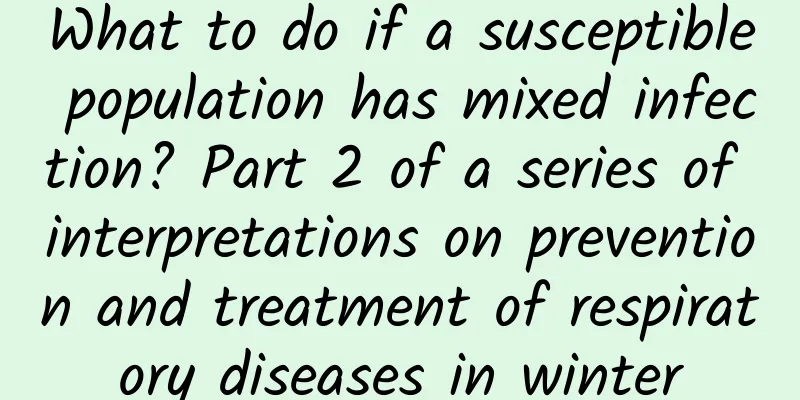What to do if a susceptible population has mixed infection? Part 2 of a series of interpretations on prevention and treatment of respiratory diseases in winter

|
On November 26, Mi Feng, spokesperson of the National Health Commission, said at a press conference that monitoring showed that influenza was the main respiratory infectious disease in my country recently. In addition, there were infections caused by pathogens such as rhinovirus, Mycoplasma pneumoniae, respiratory syncytial virus, and adenovirus. Analysis shows that the recent continuous increase in acute respiratory diseases in my country is related to the superposition of multiple respiratory pathogens. Mixed infections often cause more severe symptoms Influenza virus, rhinovirus, syncytial virus, adenovirus are all viruses, while mycoplasma is the smallest microorganism between bacteria and viruses, and Mycoplasma pneumoniae is a type of mycoplasma. Infections with the above pathogens are all self-limiting, but they can also cause pneumonia, with symptoms such as fever, cough, and wheezing. Children, the elderly and people with underlying diseases are susceptible to respiratory diseases and are more likely to be infected with two or more pathogens at the same time. Mixed infections with respiratory pathogens often have severe symptoms, with clinical manifestations including repeated high fever, severe cough, dry cough or coughing up yellow sputum, sometimes with blood in the sputum. Some patients will experience systemic symptoms such as dyspnea, chest pain, fatigue, sore throat, headache, muscle aches, and poor mental state. A small number of cases may develop severe pneumonia, acute respiratory failure, shock, etc. When patients have symptoms of respiratory infection such as fever, cough, and sore throat, the pathogen can be identified through rapid antigen testing or nucleic acid testing. If the test result is a mixed infection of two or more pathogens, several pathogens can be treated at the same time. For example, influenza combined with mycoplasma infection or combined bacterial infection is usually treated with antiviral drugs combined with antibiotics, and symptomatic treatment such as antipyretic, cough and phlegm are given at the same time. Most patients' condition will improve within 1 to 2 weeks. Those whose symptoms do not improve need to seek medical attention in time. To reduce the risk of mixed infection, high-risk groups such as the elderly, children, pregnant women, and those with underlying diseases should be vaccinated against influenza and pneumonia as soon as possible, wear masks when going to crowded places and places with poor indoor air circulation, and take a shower or wash your face and hands and rinse your nasal cavity in time after returning home. In daily life, we should maintain healthy living habits, regular work and rest, scientific exercise, balanced diet, and keep the room ventilated regularly. Complications may occur, and attention should be paid to risk indicators of severe and critical illness Whether infected with mycoplasma or viral pneumonia, complications may occur, such as pulmonary embolism, lung necrosis, acute exacerbation of bronchial asthma, neurological complications, skin and mucosal damage, etc. Some cases of mycoplasma pneumonia may also leave behind pulmonary sequelae such as obliterative bronchitis, obliterative bronchiolitis (including transparent lung), bronchiectasis, atelectasis, and organizing pneumonia, which may cause permanent damage to the lungs. Therefore, after infection with pathogens such as influenza virus or mycoplasma pneumonia, as well as mixed infections, the following indicators indicate that the patient is at risk of developing severe and critical illness and requires special attention: Persistent high fever 72 hours after treatment; presence of symptoms of infection and poisoning; rapid progression of the disease and imaging, with inflammation in multiple lobes of the lungs; difficulty in alleviating or progression of hypoxemia and dyspnea after treatment; presence of underlying diseases, including asthma and primary immunodeficiency disease; delayed antimicrobial treatment. If people experience repeated high fever, severe cough, and shortness of breath for more than 3 days, or if they have underlying diseases such as chronic respiratory diseases, cardiovascular and cerebrovascular diseases, tumors, etc. and develop respiratory infections, a lung CT scan is required to clarify the lung condition. "Lung lavage" is risky and requires standardized operation by professional doctors Whether it is mycoplasma infection or viral pneumonia, as long as the indications are met, the "lung lavage" treatment method can achieve certain results. The so-called "lung washing" refers to alveolar lavage therapy, which is a method of locally lavaging the lesions in the lungs by delivering warm saline or related therapeutic drugs to the bronchi at all levels through a bronchoscope. "Lung washing" can effectively flush out harmful substances such as mucus, abscesses and pathogenic microorganisms that cause lung infections. It has a good effect on the treatment of large-area pneumonia and can prevent patients from developing other complications such as atelectasis, long-term bronchial occlusion, and bronchiectasis. Through alveolar lavage, mycoplasma or viruses in the bronchoalveoli can be removed, reducing their continued damage to lung tissue, which is beneficial to the recovery of the disease and reduces the occurrence of sequelae. However, under normal circumstances, most children with pneumonia can control their condition through oral or intravenous medications, and usually do not need bronchoscopy to "wash the lungs." "Lung lavage" has strict operating indications. If the child's lungs are severely infected or have atelectasis, pulmonary consolidation, or necrotic material or sputum plugs blocking the trachea or bronchi, alveolar lavage under bronchoscope is required to remove inflammatory factors, sputum, and necrotic material to help clear the airways and promote the absorption of inflammation in the lesion site. At the same time, the severity of lung lesions can be observed under the microscope to help guide the next step of treatment. If necessary, multiple lavage treatments may be required depending on the condition. It should be noted that "lung lavage" has certain risks and requires a comprehensive analysis by a respiratory specialist to determine the treatment plan, and professional physicians to standardize the operation. (The first author He Meijuan is the deputy chief physician of the Department of Respiratory Medicine of Jiangxi Children's Hospital, and the second author Li Lan is the chief physician of the Department of Respiratory Medicine of Jiangxi Children's Hospital) |
<<: The second Lop Nur? Qinghai Lake, with its rich "green heritage", refuses!
>>: Not sure if there's water on Mars? Maybe we can dig a well there!
Recommend
“The bigger the waves, the more fish there are”? However, the danger is even greater! 丨 Expo Daily
“The bigger the wind and waves, the more fish the...
Life is harder than monkeys? The monkeys in the emoticons may be much worse than you
Wearing a small T-shirt, they can bow, cook, and ...
Nearly half of kidney disease patients have no obvious symptoms in the early stage! If you have these 5 signs, beware of uremia!
The human kidneys are like a "sieve" th...
How much does it cost to create a flash sale mini program in Qian'an?
According to industry insiders, mini programs wil...
Bidding promotion training institution, how long does bidding training take?
This depends on the organization. Different insti...
October marketing hotspot calendar is freshly released!
October is approaching, and the exciting National...
Why is blood sugar still out of control when eating and exercising together? Here’s the reason…
Diabetes has become widely known for its characte...
From the Hooked user incentive model, a comprehensive analysis of why "Honor of Kings" makes you addicted?
Why is " Honor of Kings " so popular? W...
iOS 16.6 update pushed, iOS 17 will be updated next week!
Early yesterday morning, Apple pushed the iOS 16....
What are the main functions and effects of Cordyceps sinensis? How to preserve Cordyceps sinensis?
Cordyceps sinensis Precautions for fresh Cordyceps...
Note 8 pre-sale price is hard to exceed 10,000 yuan. It seems Samsung has really hurt the hearts of Chinese consumers.
As the annual flagship new product, Samsung has h...
How to promote Tik Tok? What are the channels for promoting Tik Tok?
How to promote Tik Tok ? What are the channels fo...
Thinking about industrial policies and technical routes: How new energy vehicles can sail far
As we all know, the new energy vehicle industry e...









